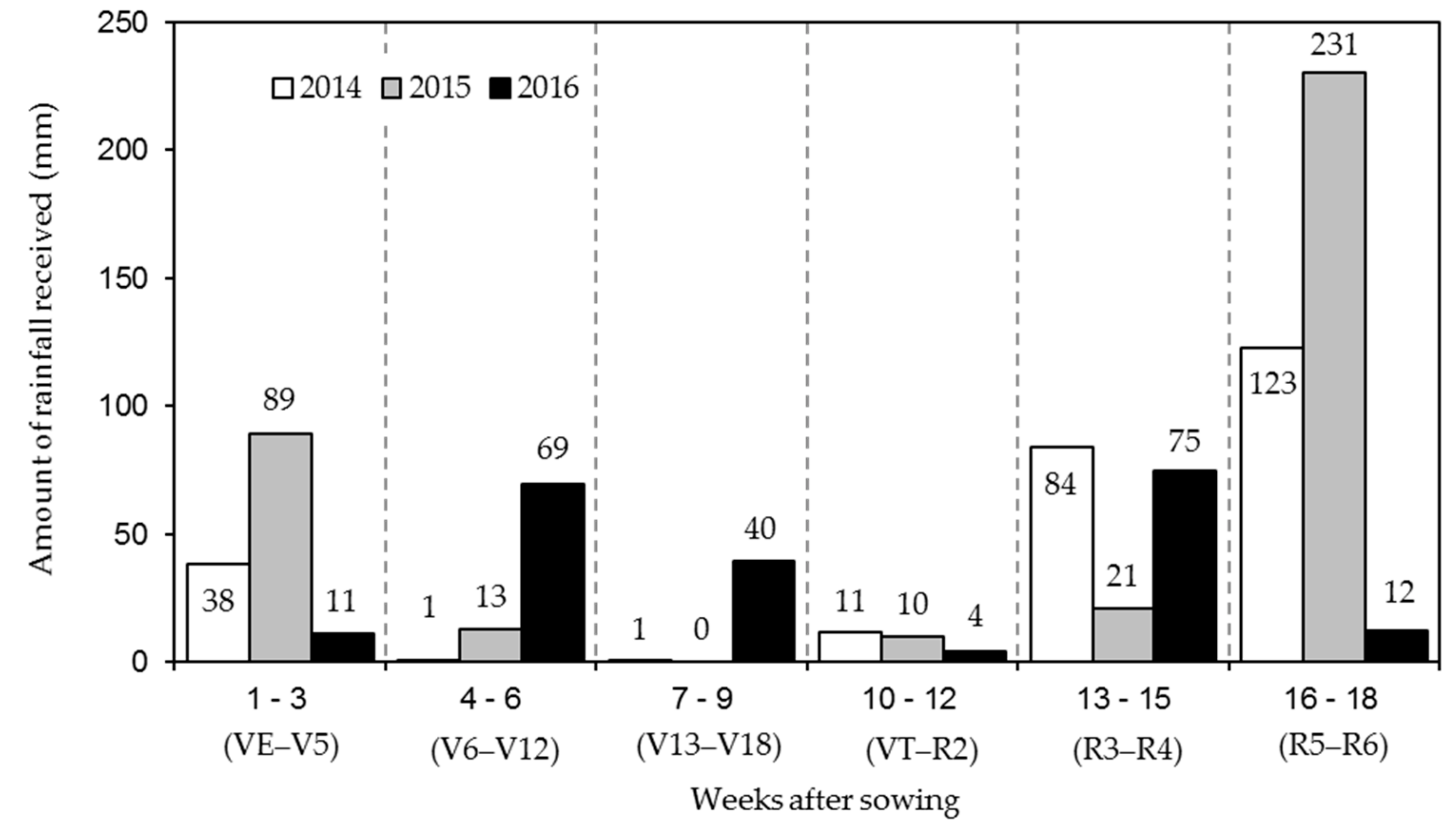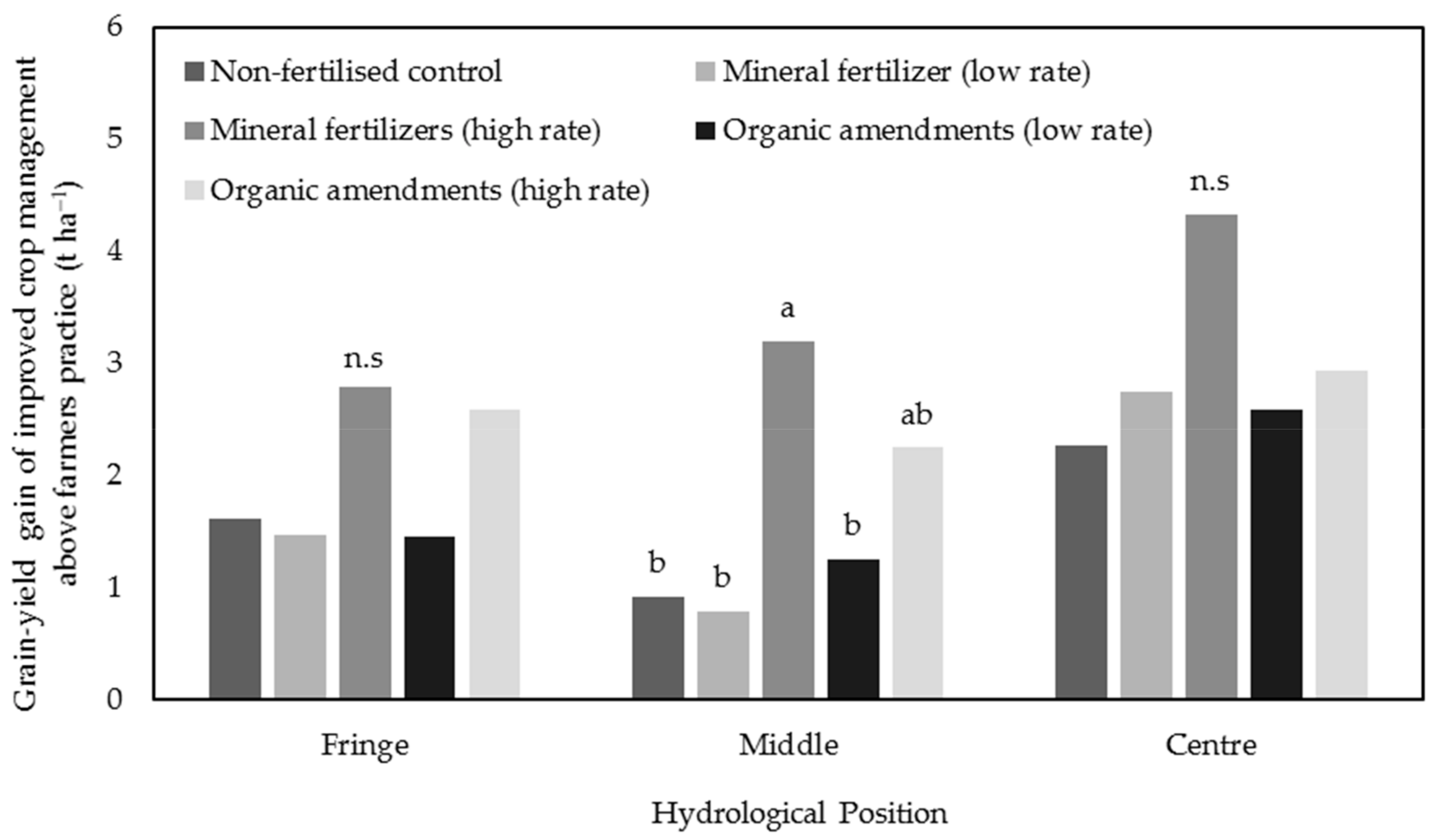Potential of Cultivating Dry Season Maize along a Hydrological Gradient of an Inland Valley in Uganda
Abstract
:1. Introduction
2. Materials and Methods
2.1. Description of the Experimental Site
2.2. Experimental Design and Setup
2.3. Measurements
2.4. Statistical Analysis
3. Results
3.1. Leaf Relative Chlorophyll Content
3.2. Maize Growth and Biomass Productivity
3.3. Maize Grain Productivity
3.4. Grain Yield Gain of Improved Crop Management
3.5. Agronomic N-Use Efficiency (aNUE)
4. Discussion
4.1. Effect of Hydrological Position
4.2. Effect of Crop Management
5. Conclusions
Author Contributions
Funding
Acknowledgments
Conflicts of Interest
References
- Daly, J.; Hamrick, D.; Guinn, A. Maize Value Chains in East Africa F-38202-RWA-1; International Growth Centre: London, UK, 2016. [Google Scholar]
- Smale, M.; Byerlee, D.; Jayne, T. Maize Revolutions in Sub-Saharan Africa; Michigan State University: East Lansing, MI, USA, 2011. [Google Scholar]
- Drought Tolerant Maize for Africa DT Maize: A quarterly bulletin of the drought tolerant maize for Africa Project. DT Maize 2015, 4, 1–4.
- Lukuyu, B.A.; Baker, D.; Baltenweck, I.; Poole, E.J.; Kabi, F.; Katongole, C.; Nadiope, G.; Byarugaba, A.A.; Kugonza, J.; Wabwire, R. The Concentrate Feeds Supply Chain in Uganda: Emerging Trends and Implications on Quality and Access to Smallholder Farmers and Chain Efficiency; East Africa Dairy Development Project: Nairobi, Kenya, 2013. [Google Scholar]
- United States Department of Agriculture. Kenya Corn, Rice and Wheat Grain and Feed Annual Report 2016; United States Department of Agriculture: Washington, DC, USA, 2016.
- Ahmed, M.; Ojangole, S. Analysis of Price Incentives for Maize in Uganda for the Time Period 2005–2013; FAO: Rome, Italy, 2014. [Google Scholar]
- Cairns, J.E.; Hellin, J.; Sonder, K.; Araus, J.L.; MacRobert, J.F.; Thierfelder, C.; Prasanna, B.M. Adapting maize production to climate change in sub-Saharan Africa. Food Secur. 2013, 5, 345–360. [Google Scholar] [CrossRef] [Green Version]
- NEPAD. African Agriculture: Transformation and Outlook; NEPAD: Midrand, South Africa, 2013. [Google Scholar]
- Sakané, N.; Alvarez, M.; Becker, M.; Böhme, B.; Handa, C.; Kamiri, H.W.; Langensiepen, M.; Menz, G.; Misana, S.; Mogha, N.G.; et al. Classification, characterisation, and use of small wetlands in East Africa. Wetlands 2011, 31, 1103–1116. [Google Scholar] [CrossRef]
- Jogo, W.; Hassan, R. Balancing the use of wetlands for economic well-being and ecological security: The case of the Limpopo wetland in southern Africa. Ecol. Econ. 2010, 69, 1569–1579. [Google Scholar] [CrossRef] [Green Version]
- Scoones, I. Wetlands in drylands: Key resources for agricultural and pastoral production in Africa. AMBIO A J. Hum. Environ. 1991, 20, 366–371. [Google Scholar]
- McCartney, M.; Rebelo, L.M.; Senaratna Sellamuttu, S.; de Silva, S. Wetlands, Agriculture and Poverty Reduction; International Water Management Institute: Colombo, Sri Lanka, 2010. [Google Scholar]
- Nabahungu, N.L.; Visser, S.M. Contribution of wetland agriculture to farmers’ livelihood in Rwanda. Ecol. Econ. 2011, 71, 4–12. [Google Scholar] [CrossRef]
- Wetlands Management Department, Ministry of Water and Environment of Uganda; UBOS; ILRI; WRI. Mapping a Better Future: How Spatial Analysis can Benefit Wetlands and Reduce Poverty in Uganda; WRI: Washington, DC, USA, 2009.
- Uganda Bureau of Stastistics. Summary Report on Uganda Census of Agriculture; Uganda Bureau of Stastistics: Kampala, Uganda, 2010.
- Rebelo, L.M.; McCartney, M.P.; Finlayson, C.M. Wetlands of Sub-Saharan Africa: Distribution and contribution of agriculture to livelihoods. Wetl. Ecol. Manag. 2010, 18, 557–572. [Google Scholar] [CrossRef]
- Matsumoto, T.; Yamano, T. Optimal Fertilizer Use on Maize Production in East Africa. Emerg. Dev. Agric. East. Africa 2011, 117–132. [Google Scholar] [CrossRef]
- Tsuboi, T.; Asea, G.; Maruyama, A.; Matsumoto, S.; Miyamoto, K.; Goto, A.; Justin, E.S.; Inubushi, K.; Ikeda, R.; Takagaki, M.; et al. Effects of rainfall, continuous cropping, and fertilizer on yield and yield components of an upland NERICA variety: A statistical analysis of a long- term field experiment in Uganda. Trop. Agric. Dev. 2018, 62, 78–93. [Google Scholar]
- Ritchie, S.W.; Hanway, J.J.; Benson, G. How a Corn Plant Develops; Iowa State University: Ames, IA, USA, 1986. [Google Scholar]
- Gabiri, G.; Diekkrüger, B.; Leemhuis, C.; Burghof, S.; Näschen, K.; Asiimwe, I.; Bamutaze, Y. Determining hydrological regimes in an agriculturally used tropical inland valley wetland in Central Uganda using soil moisture, groundwater, and digital elevation data. Hydrol. Process. 2018, 32, 349–362. [Google Scholar] [CrossRef]
- Badu-Apraku, B.; Fakorede, M.A.B.; Menkir, A.; Sanogo, D. Conduct and Management of Maize Field Trials Conduct and Management; IITA: Ibadan, Nigeria, 2012. [Google Scholar]
- Cassman, K.G.; Peng, S.; Olk, D.C.; Ladha, J.K.; Reichardt, W.; Dobermann, A.; Singh, U. Opportunities for increased nitrogen-use efficiency from improved resource management in irrigated rice systems. F. Crop. Res. 1998, 56, 7–39. [Google Scholar] [CrossRef]
- IRRI. Statistical Tool for Agricultural Research (STAR) 2014; IRRI: Los Banos, Philipines, 2014. [Google Scholar]
- Nyamadzawo, G.; Wuta, M.; Nyamangara, J.; Nyamugafata, P.; Chirinda, N. Optimizing dambo (seasonal wetland) cultivation for climate change adaptation and sustainable crop production in the smallholder farming areas of Zimbabwe. Int. J. Agric. Sustain. 2015, 13, 23–39. [Google Scholar] [CrossRef]
- Carter, M.R. Soil Quality for Sustainable Land Management. Agron. J. 2010, 94, 38. [Google Scholar] [CrossRef]
- Mzuku, M.; Khosla, R.; Reich, R.; Inman, D.; Smith, F.; MacDonald, L. Spatial Variability of Measured Soil Properties across Site-Specific Management Zones. Soil Sci. Soc. Am. J. 2005, 69, 1572. [Google Scholar] [CrossRef]
- Maddonni, G.Á.; Martínez-Bercovich, J. Row Spacing, Landscape Position, and Maize Grain Yield. Int. J. Agron. 2014, 2014, 1–12. [Google Scholar] [CrossRef] [Green Version]
- Piekkielek, W.P.; Fox, R.H. Use of a Chlorophyll Meter to Predict Sidedress Nitrogen. Agron. J. 2010, 84, 59. [Google Scholar] [CrossRef]
- Phiri, R.H.; Kanyama-Phiri, G.Y.; Snapp, S. Soil nitrate dynamics in relation to nitrogen source and landscape position in Malawi. Agrofor. Syst. 1999, 47, 253–262. [Google Scholar] [CrossRef]
- Bernal, M.P.; Alburquerque, J.A.; Moral, R. Composting of animal manures and chemical criteria for compost maturity assessment. A review. Bioresour. Technol. 2009, 100, 5444–5453. [Google Scholar] [CrossRef]
- Chae, Y.M.; Tabatabai, M.A. Mineralization of Nitrogen in Soils Amended with Organic Wastes1. J. Environ. Qual. 2010, 15, 193. [Google Scholar] [CrossRef]
- Chuan, L.; He, P.; Pampolino, M.F.; Johnston, A.M.; Jin, J.; Xu, X.; Zhao, S.; Qiu, S.; Zhou, W. Establishing a scientific basis for fertilizer recommendations for wheat in China: Yield response and agronomic efficiency. F. Crop. Res. 2013, 140, 1–8. [Google Scholar] [CrossRef]
- Bremner, J.M. Nitrogen-total. In Methods of Soil Analysis; Sparks, D., Ed.; Soil Science Society of America: Madison, WI, USA, 1996; pp. 1085–1121. [Google Scholar]
- Dibb, D.W. The Mysteries (Myths) of Nutrient Use Efficiency. Better Crop. 2000, 84, 3–5. [Google Scholar]
- Liu, K.; Ma, B.L.; Luan, L.; Li, C. Nitrogen, phosphorus, and potassium nutrient effects on grain filling and yield of high-yielding summer corn. J. Plant. Nutr. 2011, 34, 1516–1531. [Google Scholar] [CrossRef]
- Osborne, S.L. Enhancing corn production through the use of starter fertilizer in the northern Great Plains. Commun. Soil Sci. Plant. Anal. 2005, 36, 2421–2429. [Google Scholar] [CrossRef]






| Treatments | N | P | K | Fertilizer Application Rate |
|---|---|---|---|---|
| kg ha−1 | kg ha−1 Season−1 | |||
| Farmer’s practice (weeded once) | 0 | 0 | 0 | — |
| Non-fertilized control (weed free) | 0 | 0 | 0 | — |
| Mineral fertilizer—low rate (weed free) | 60 | 0 | 0 | 130 urea |
| Mineral fertilizers—high rate (weed free) | 120 | 60 | 60 | 261 urea + 130 TSP + 100 Potassium chloride (KCl) |
| Organic amendments—low rate (weed free) | 60 | 3 | 35 | 5929 Lablab purpureus (Linnaeus) Sweet (fresh weight basis) |
| Organic amendments—high rate (weed free) | 120 | 18 | 79 | 5929 L. purpureus + 6758 poultry manure (fresh weight basis) |
| Crop Management | Plant Height (m) | Above-Ground Biomass at Tasseling (t dm ha−1) | ||||
|---|---|---|---|---|---|---|
| Fringe | Middle | Center | Fringe | Middle | Center | |
| Farmer’s practice (weeded once) | 1.08 d | 1.23 c | 1.58 c | 1.32 c | 1.68 c | 2.69 c |
| Non-fertilized control | 1.27 c | 1.23 c | 1.86 b | 1.97 bc | 1.76 c | 3.45 bc |
| Mineral fertilizer (low rate) | 1.34 bc | 1.20 c | 1.86 b | 1.85 bc | 1.66 c | 3.0 bc |
| Mineral fertilizers (high rate) | 1.61 a | 1.77 a | 2.12 a | 3.35 a | 3.90 a | 4.54 a |
| Organic amendments (low rate) | 1.28 c | 1.36 bc | 1.85 b | 1.72 bc | 2.13 c | 3.88 ab |
| Organic amendments (high rate) | 1.49 ab | 1.52 b | 1.91 b | 2.52 ab | 2.98 b | 3.63 b |
| LSD (5%) | 0.17 | 0.2 | 0.16 | 0.93 | 0.77 | 0.81 |
| Crop Management | Fringe | Middle | Center | Overall Mean |
|---|---|---|---|---|
| Mineral fertilizer (low rate) | −2.5 b | −2.2 c | 8 | 1.1 b |
| Mineral fertilizers (high rate) | 9.8 a | 19.3 a | 17.1 | 15.4 a |
| Organic amendments (low rate) | −2.7 b | 5.6 bc | 5.2 | 2.7 b |
| Organic amendments (high rate) | 8.2 a | 11.1 ab | 5.5 | 8.2 ab |
| Mean | 3.2 | 8.4 | 9.0 | 6.9 |
| LSD (5%) | 9 | 12.6 | n.s | 9.8 |
© 2019 by the authors. Licensee MDPI, Basel, Switzerland. This article is an open access article distributed under the terms and conditions of the Creative Commons Attribution (CC BY) license (http://creativecommons.org/licenses/by/4.0/).
Share and Cite
Alibu, S.; Neuhoff, D.; Senthilkumar, K.; Becker, M.; Köpke, U. Potential of Cultivating Dry Season Maize along a Hydrological Gradient of an Inland Valley in Uganda. Agronomy 2019, 9, 606. https://doi.org/10.3390/agronomy9100606
Alibu S, Neuhoff D, Senthilkumar K, Becker M, Köpke U. Potential of Cultivating Dry Season Maize along a Hydrological Gradient of an Inland Valley in Uganda. Agronomy. 2019; 9(10):606. https://doi.org/10.3390/agronomy9100606
Chicago/Turabian StyleAlibu, Simon, Daniel Neuhoff, Kalimuthu Senthilkumar, Mathias Becker, and Ulrich Köpke. 2019. "Potential of Cultivating Dry Season Maize along a Hydrological Gradient of an Inland Valley in Uganda" Agronomy 9, no. 10: 606. https://doi.org/10.3390/agronomy9100606
APA StyleAlibu, S., Neuhoff, D., Senthilkumar, K., Becker, M., & Köpke, U. (2019). Potential of Cultivating Dry Season Maize along a Hydrological Gradient of an Inland Valley in Uganda. Agronomy, 9(10), 606. https://doi.org/10.3390/agronomy9100606





